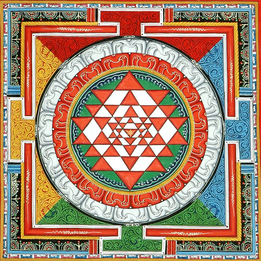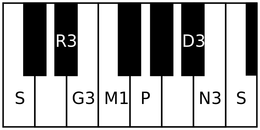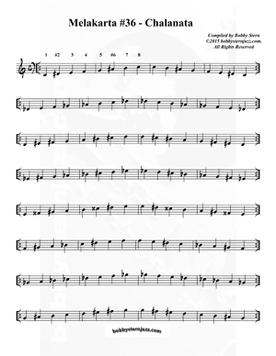Mela Down Easy With #36
Chalanata

Checking it out from a Western point of view as a tool for improvisational vocabulary, which is my main intention; Chalanata is a seven note symmetrical scale; the two tetrachords being built off of the exact same interval scheme.
C - D# - E - F / G - A# - B - C
1 1/2 1/2 1/2 1 1 1/2 1/2 1/2
The sound of Chalanata should already be pretty familiar to many, as 5 of its seven scale tones form a much used minor pentatonic scale:
In C: C - D# - F - G - A# = C minor pentatonic (aka 5th mode of Eb Maj. pentatonic).

D# Penta b2 = D#-E-G-A#-C (also found in the diminished scale)
D# Penta b6 = D#-F-G-A#-B (also found in Ab Melodic Minor)
As each of these two pentatonics contains a tritone (E-A# & F-B), some kind of V-I harmonic resolution could be implied in each case.
It's inherent triads, built in thirds are C Maj., C min., D# Maj., D# aug., E min. & E dim.
Because of this scale's interval layout, the common tone among all these triads turns out to be "G" in each case; which means that there are no mutually exclusive triad pairs available in Chalanata.
One of the more interesting aspects of the Melakarta system of scales is the phenomenon of graha bedham; which shifts the tonal center (root) of a scale to another note of that same scale, while retaining its original notes and interval make up; similar to the Western modal system (D dorian, E phrygian, F lydian, etc. in C Maj.).
A certain set of criteria must be met in order for for a scale to be considered a legit member of the 72 scale Melakarta family. However, many very different sounding and intriguing scales, legit or not, can be formed by this method.
In the case of Chalanata, if we take the same 7 notes and hear "E" as the root (and "B" as the 5th) of the scale, we get Mela #45 - Shubhapantuvarali, which creates a whole different vibe and atmosphere, but nevertheless, very hip and mysterious.
Chalanata, in all it's forms, is a beautiful scale, familiar yet exotic, which lays easily on the ears and in the fingers and contains an inherently sophisticated, yet funky, bluesy quality.
Cha-la-nata! Sounds kind of "creamy"!
| Before performing the Chalanata ragam, Dr. Pantula Rama, explains its structure and note names, and that the more popular method of performing this scale is through it's offshoot janya raga, known as Nata, which omits the notes "da" & "ga" (Bb & E, in C) while descending the scale. | This video is evidence that MF was hip to Chalanata back in the '70s. This is a pretty cool arrangement, in a Las Vegas-y sort of way. |
| | |

 RSS Feed
RSS Feed









